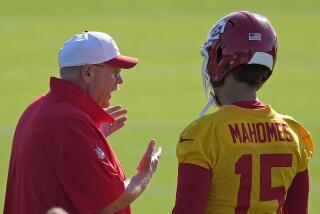Lockout creates a code of silence between NFL employees and agents
- Share via
Where once there were conversations, now there’s mostly silence.
The gush of information has slowed to a trickle.
Now, anything more than a simple hello between NFL team employees and player agents needs to be logged and detailed.
The lockout hasn’t just impacted owners and players — the most vocal parties in this labor fight — but has dramatically changed the way the league does business. Or doesn’t do business.
Amid NFL lockout, battered retirees talk justice
That was evident Tuesday at UCLA’s pro day, when agents and scouts cordially kept their distance from each other, and it will be just as obvious when USC has its pro day Wednesday.
The agents are unregulated; their governing body went away when the NFL Players Assn. decertified as a union. But the league has instructed team employees that they should only speak with agents about draft prospects; nothing about current players.
That has made for some awkward encounters.
At UCLA, for instance, agent Chuck Price bumped into Ted Thompson, general manager of the Green Bay Packers. In another year, they would have much to discuss. Price represents Packers linebacker Nick Barnett, as well as Bruins rookie-to-be Akeem Ayers, a potential first-round pick.
“I saw Ted and said, ‘We’re not supposed to talk, are we?’ ” Price said. “He said, ‘Well, you can talk, but I have to turn around and walk away.’
“I’ve got a player there under contract whose future is uncertain, and nobody would have more information in an open dialogue about it than Ted, and I’ve got a few guys in this year’s draft that I would love to have a dialogue about. But he wasn’t going to have any of it.”
Price and other agents don’t resent that; it’s the strange new world of the NFL, where walls now exist where they didn’t before.
“In many respects this is uncharted territory,” said agent Sean Howard, a former UCLA player who watched pro day from behind a taped-off boundary. (Agents, players’ family members and spectators were not allowed on the practice field.) “The last work stoppage was a strike [in 1987]. With the lockout, we’re all trying to get used to new rules.”
UCLA’s Akeem Ayers tries to improve NFL draft stock
Seattle Seahawks Coach Pete Carroll acknowledged that even now, months before the scheduled start of the season, the imposed silence between teams and veteran players has created challenges.
“I miss the fact that we’re not seeing these young guys come around anymore and working at the facility,” Carroll said. “We could be hanging around with them, watching what’s going on, and helping the process move ahead. But nobody else is getting to do that either.”
Agent Ben Dogra said at this time of year he’s typically spending a lot of time on the phone talking to teams about free agents he represents and where they might fit on a roster. Now, he finds himself talking to players about the realities of the lockout.
“Players want to know about what happens if we get a favorable or unfavorable ruling from the court,” Dogra said, referring to the players’ April 6 hearing on a class-action antitrust lawsuit against the league. “They want to know about insurance, where they should train without an off-season program. You’re dealing with a lot of things that you’ve never dealt with before.”
If there’s no labor agreement before the NFL draft at the end of April, there will be more complications. Teams will be able to speak with players they select only before and during the draft. Drafted players can be introduced to the local media the next day but cannot receive playbooks, information from their new coaches … really anything of substance.
Although the draft will remain intact, the annual scramble to sign rookie free agents who were not selected will not. There is no free agency, and only picks can be traded, not players.
“In every other year, there’s an adrenaline rush when you have 15 to 20 teams calling on one player,” agent Bruce Tollner said. “Head coaches are calling and recruiting them, sharing why they’re the best place to go. That’s an exciting time, and at this point it looks like it won’t happen.”
Once there is a resolution to the labor crisis, assuming it comes after the draft, the league would set a date to begin the free-agent signing period.
“If that happens, it will be different than ever before,” Tollner said. “Maybe you’ll have time to communicate with teams over days, as opposed to on the spot. A lot of times it’s, ‘Hey, you have 15 minutes. Let me know, or we’re moving on to our next guy.’ That dynamic of those transactions might be much different.”
Then again, different is the new normal.
twitter.com/LATimesfarmer
More to Read
Go beyond the scoreboard
Get the latest on L.A.'s teams in the daily Sports Report newsletter.
You may occasionally receive promotional content from the Los Angeles Times.











